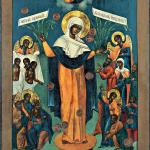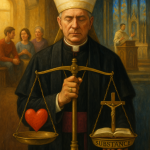HOW FAR CAN YOU GO?: That was the original and best title of the book I just finished, published in the US as Souls and Bodies. It’s a novel (…sort of) by David Lodge, basically about how a group of young English Catholics respond to the Second Vatican Council and Humanae Vitae. These are going to be scattershot and rushed impressions, because I’m leaving to return the book to the library in about fifteen minutes…. This is a negative review because that’s the final impression the book left on me, not because all of it is lame.
1. At first the book was both easy to read and compelling. There’s a wry tone, sometimes but not often skating into too-clever-by-half (the “Snakes and Ladders” depiction of Catholic metaphysics, which is, honestly, much too easy a comparison to be illuminating). Because the prose moves quickly I didn’t notice that the characters are fairly slight and their future trajectories perhaps obvious from the beginning.
2. This is almost always a novel about The Church, not a novel about (say) salvation, Christ, redemption from sin, or even, really, faith and suffering. Those last two themes do surface in the book, but they’re seen through what I found to be an entirely this-worldly lens, a “muddling through, do your best” kind of lens. Which is fine, obviously that’s one perspective on the world, but it’s… not something I’m wildly interested in. There’s nothing wrong with writing a novel that dates, but it’s worth mentioning that this novel is, in fact, dated. That’s really the point of this novel (as the final lines, noting the election of Pope John Paul II, make explicit): to capture one time and place from an entirely temporal, secular perspective. The interest lies, maybe, in the clash between the secular perspective of the novel (and, ultimately, the protagonists) and the eternity-minded claims of the Catholic Church.
3. Souls and Bodies is more honest about death than about sex; and the book’s American title makes most sense in the passages on death. I found the book most powerful in two areas: the sections that depicted the aging body and the threat of death; and the sections that show how different ways of life often simply change one form of unhappiness for another. (There are at least two moments when a married character and an unmarried character confront each other, each embedded in their own specific unhappiness, and each thinking, That’s easy for you to say.)
4. As far as sex: If you already have an opinion on Humanae Vitae, I can guarantee that you will already have heard everything this book has to say about it. I don’t know if Lodge’s presentation of the issues was fresher in 1980, but it’s definitely non-exciting now. And it damages the novel in at least two ways: a. There’s a several-page essay just jammed into the book’s midsection, arguing against the encyclical; you can’t get away with doing that in your novel.
b. The book is manipulative. I noticed this manipulation when I realized that although three couples in the book have children, only one child is actually given a personality or described at any length. This child, Nicole, is born with Down’s Syndrome (which is implied to be a result of her parents’ use of the “rhythm method”…), and although there are a lot of poignant moments in her portrayal, it’s hard not to get the sense that she’s there to be the Bad Thing that happens to Good People. I’m pretty sure that sense would be much less if any of the other children were more than just names.
5. I shouldn’t make it sound like Lodge was unaware of the snakes breeding in the sexual-revolutionary garden. The book has passages very reminiscent of “The Ice Storm”–people who want to be good, but who have no compass, nothing but desire and fear. I do really like the British title (although his editor should have scissored a few of the explicit references to it within the text); it’s clear that Lodge knows that it’s possible to go too far. (Even if he doesn’t know where “too far” begins.)
6. I wonder why that question–How far can you go?–is almost always asked to discern how far you can go from the Church. Why not, How far can you go for Christ? Perhaps an obvious point. But this novel, I think, assumes that everyone’s perspective is basically, How tall do I have to be to ride this ride? What is the minimum necessary?, when it’s quite clear that some people do end up asking, What is the maximum possible? …And that strikes me as the more interesting question.
Have any of you all read Lodge? This is my first of his. I have Thinks… on my reading list for later. Am I off-base, am I missing the point, should I read his other books? Your thoughts welcome.











